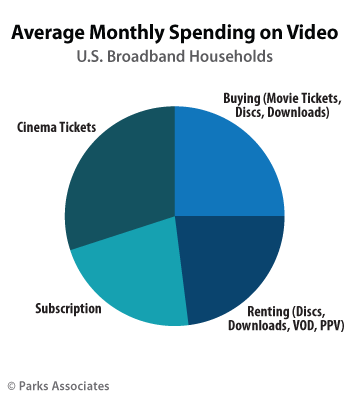US consumers spend >$6 per month on subscription OTT video
Thursday, January 28th, 2016
Consumers Spend Over $6 per Month on Netflix, Hulu Plus, and Other Subscription OTT Video
- New Report Addresses Challenges for Content Companies with Changing Business Models
Parks Associates announced a new research report today showing average monthly spending on Internet-based subscription video-on-demand (SVOD) services among U.S. broadband households increased from $3.71 per month in 2012 to $6.19 per month in 2015. Content Strategies: Survival in the New Video World examines new business models emerging from the increasing consumption of OTT content, including new experiments in content windowing, which is the process of releasing content at different times through different distribution channels in order to maximize revenues for each channel.

“Multiple content players have held onto traditional content windowing strategies for years, but OTT technologies and emerging business models have finally forced these companies to experiment with new windowing strategies,” said Glenn Hower, Research Analyst, Parks Associates. “New models for movies include day-and-date availability, as with the movie Beasts of No Nation, where it was released for streaming the same day as in the theater. For streaming TV shows like Jessica Jones or Transparent, viewers can watch full seasons all at once, satisfying binge-happy viewers. Consumers have quickly adopted these new habits as part of their OTT monthly subscriptions.”
A typical price point for a subscription service is $7-$10, but several niche services are available for under $5, according to Hower. U.S. broadband households on average spend less than $1 per month buying and less than $1 per month renting digital video, indicating they purchase less than one digital video a year and rent between one and four videos per year.
“The subscription model clearly dominates in the U.S., which could create a disconnect in value propositions between consumers and content providers, who might seek out revenues from more lucrative transactional services over low-margin SVOD services,” Hower said. “Currently they are exploiting multiple digital distribution outlets to monetize current and library TV content, including authenticated catch-up players, third-party aggregators, and direct-to-consumer subscription services. There are also bidding wars for premium library TV content, with Netflix paying a reported $118 million for Friends and Hulu paying a reported $160 million for Seinfeld.”
Content Strategies: Survival in the New Video World identifies current opportunities and threats to video distribution models and provides recommendations for creating a more consistent user experience for the connected consumer. Hower will participate at Digital Entertainment World in Los Angeles next month. He will join YouTube, BuzzMyVideos, Big Frame, and All Def Digital on the panel “The Future of MCNs and the Video Economy” at 12:15 PM on Thursday, February 11.
Latest News
- Graham Media Group selects Bitmovin Playback
- Dialog, Axiata Group, Bharti Airtel agree on merger in Sri Lanka
- Yahoo brings identity solutions to CTV
- Plex has largest FAST line-up with 1,112 channels
- TV3 migrates from on-prem servers to AWS Cloud with Redge
- Virgin Media partners with PubMatic to scale FAST advertising